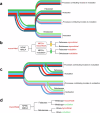One versus many independent assemblies of symbiotic nitrogen fixation in flowering plants
- PMID: 40537475
- PMCID: PMC12179287
- DOI: 10.1038/s41467-025-60433-w
One versus many independent assemblies of symbiotic nitrogen fixation in flowering plants
Abstract
Some species of legumes and nine other flowering plant families form symbioses with bacteria that fix atmospheric nitrogen within specialized plant structures called nodules. How and how often nodulation symbiosis originated has implications for engineering symbiotic nitrogen fixation in non-legume crops. The prevailing hypothesis of a single origin with massive parallel losses has been challenged in a phylogenomic study favoring 16 origins and 10 losses. Nodulation has been assembled once or many times from existing processes (e.g., mycorrhizal symbiosis) and therefore almost nothing about it is truly novel. Because any feature of nodulation can be explained either as divergence from a common origin or as convergence in unrelated taxa, tests are needed that can distinguish whether assembly of homologous components has occurred uniquely or convergently. Much needs to be learned about nodulation symbioses across the proposed independent origins, especially involving the master nodulation transcription factor, Nodule Inception (NIN).
© 2025. The Author(s).
Conflict of interest statement
Competing interests: The authors declare no competing interests.
Figures




Similar articles
-
From roots to nodules: regulation of organogenesis in nitrogen-fixing symbiosis.Curr Opin Plant Biol. 2025 Aug;86:102755. doi: 10.1016/j.pbi.2025.102755. Epub 2025 Jun 28. Curr Opin Plant Biol. 2025. PMID: 40582138 Review.
-
Conserved cis-elements enable NODULES WITH ACTIVATED DEFENSE1 regulation by NODULE INCEPTION during nodulation.Plant Cell. 2024 Oct 3;36(10):4622-4636. doi: 10.1093/plcell/koae229. Plant Cell. 2024. PMID: 39136552 Free PMC article.
-
Evolution of NIN and NIN-like Genes in Relation to Nodule Symbiosis.Genes (Basel). 2020 Jul 11;11(7):777. doi: 10.3390/genes11070777. Genes (Basel). 2020. PMID: 32664480 Free PMC article. Review.
-
The receptor-like cytoplasmic kinase AeRLCK2 mediates Nod-independent rhizobial symbiosis in Aeschynomene legumes.Plant Cell. 2025 Aug 4;37(8):koaf201. doi: 10.1093/plcell/koaf201. Plant Cell. 2025. PMID: 40811611 Free PMC article.
-
Comparative genomics of the nonlegume Parasponia reveals insights into evolution of nitrogen-fixing rhizobium symbioses.Proc Natl Acad Sci U S A. 2018 May 15;115(20):E4700-E4709. doi: 10.1073/pnas.1721395115. Epub 2018 May 1. Proc Natl Acad Sci U S A. 2018. PMID: 29717040 Free PMC article.
References
Publication types
MeSH terms
LinkOut - more resources
Full Text Sources

